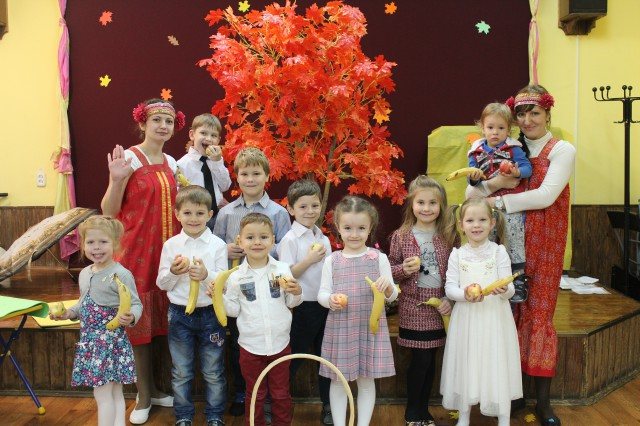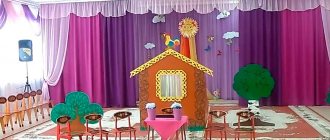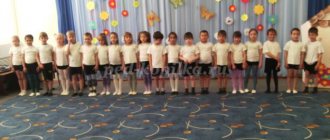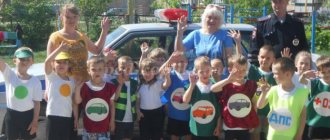Why do you need to dramatize a fairy tale in kindergarten?
It is difficult to overestimate the importance of theatrical activities in a preschool educational institution. In the process of learning and showing the production, the child is raised, morally and physically. Children come to kindergarten to join society; they must learn to speak in public, memorize text, and get involved in gaming or work processes. The teacher’s task is to conduct an interesting game, inserting a cognitive element into it and arousing interest among young actors. Dramatizing a fairy tale in a preparatory group helps show children how they can and cannot behave in different situations.
Matinee in kindergarten
Important! Performances in kindergarten are carried out in accordance with the Federal State Educational Standard, according to the approved program. You can choose well-known fairy tales, such as “The Clapping Fly” or “Little Red Riding Hood,” or show your imagination and stage an unusual production.
The easiest way to introduce a preschooler to national culture is through Russian folk art. At the age of 5, children absorb the wisdom and beauty of fairy tales like a sponge, let everything pass through them, and for the first time think about what is good and what is bad.
Another, no less important goal is aesthetic education. Staging Russian folk works allows you to:
Children from the younger group can prepare a fairy tale and role-play it. A New Year's or autumn party is perfect for this. You can also prepare a fairy tale for the holiday for mothers and for the autumn holiday. In general, 3-5 dramatizations can be prepared per year.

Note! The performance should not last longer than 15 minutes. Children who go to kindergarten are not yet ready for long performances. Dramatization is primarily a game, which means kindergarten students can laugh, dance and chat happily with each other.
How to introduce a preparatory group to the theater
It should be remembered that the decision to agree or disagree with a child’s enrollment in any creative club is made by parents. In this regard, you should first discuss with them the details of the children’s future development, since competent planning is the key to successful activities.
When an agreement is reached between all parents, educators need to instruct mothers and fathers about the rules for conducting preparatory conversations with children, which are necessary for the moral preparation of children for the upcoming activity.
The ground rules can be printed out and given to each person, or parents can be asked to jot down the most important information.
When introducing the preparatory group to the theater, the specifics and general patterns of development of children of certain ages are taken into account. To carry out theatrical activities in the most comfortable conditions for the child, the program provides classes on various topics, it includes techniques for joint performance with parents and educators, which allows the child to relax and feel freer in communication.
Important! To minimize stress in children who find themselves in the field of theatrical art for the first time, it is necessary to consider the roles of each child individually. Functions that involve interaction with several other theatergoers should not be assigned to shy children or children with pronounced introversion.
A charismatic, promising and artistic child must be given the opportunity to discover and multiply his talents; for this, you can assign him the role of an active character, the storyline of which involves reading poems, dialogues with other theatergoers, etc. Over time, teachers should revise the “fixed” ones. take on roles for children, involve them in other activities
Functions that involve interaction with several other theatergoers should not be assigned to shy children or children with pronounced introversion. A charismatic, promising and artistic child must be given the opportunity to discover and multiply his talents; for this, you can assign him the role of an active character, the storyline of which involves reading poems, dialogues with other theatergoers, etc. Over time, teachers should revise the “fixed” ones. role for children, involve them in other types of activities.
Education of cultural and hygienic skills in the 2nd junior group
Rehearsals, discussions and other forms of preparation for productions should take place in forms that allow young theatergoers to quickly adapt and become interested in new roles. For example, the perception of famous characters from fairy tales can be simplified by showing children fragments from films or cartoons, or using pictures presented using a multimedia presentation. If it is possible to purchase paper booklets with information about the characters being played, it is recommended to do so.
Introduction to the fairy tale
Project on theatrical activities in accordance with the Federal State Educational Standard
Based on the provisions established by the Federal State Educational Standard for preschool education, approved in 2013 by order of the Ministry of Education and Science of the Russian Federation, the educational program should promote not only artistic, aesthetic and communicative advancement, but also contribute to the formation of cognitive interest, speech and physical development.
Preschoolers in kindergartens have the opportunity to participate in the types of theatrical activities presented below.
Stand theater
This art is the acting out of various scenes with the help of figures and decorations on a certain surface. The most common options are fabric stretched over a stand board, paper and fabric figures necessary for the plot are attached to it, and they move as the plot develops; arrangement of decorations on a magnetic board; a game of shadows, for which a lantern or lamp is pointed at a stretched white fabric, thereby illuminating black figures or hands, if “living shadows” are practiced.
Shadow theater in kindergarten
Theater on the table
The scenery and characters are made of paper (cardboard), natural materials (pine cones, autumn leaves, etc.), magnetic figures of the characters are also used - all of them are placed on the table on which the actions take place.
Finger Theater
In this type of theatrical activity, the main characters of the plots are presented in the form of dolls that are put on the hands, and each finger can represent a separate character. The preparatory group may be interested in the process of creating such dolls, so it is preferable to make them yourself from fabrics, cardboard, plastic objects and other scrap materials.
Didactic games for the younger group of kindergarten
Horse Theater
It involves the use of dolls placed above human height. Usually they are fixed on long boards. Also on horseback can be a finger theater, which is located high above the stage and in which the puppeteers are blocked by a dense screen.
Theater on the floor
The main principle of this theatrical performance is that the scenes are shown low above the floor, for which puppets are used. Since managing them requires more than a child’s dexterity and attentiveness, children should be involved in preparing the scenery and costumes for the dolls, and the performance itself should be conducted by the teacher.
Living Puppet Theater
It is understood that the heroes of the productions are the children themselves, and not the dolls controlled by them. Kids put on masks, as well as character costumes sewn onto aprons, conveying the movements of the characters with their bodies. “Live” dolls are often used at matinees and in speech development exercises. At concerts dedicated to national holidays, kindergartens stage fully costumed performances, preparation for which can take several months.
Living Puppet Theater
There are many original projects on the Internet containing sets of exercises and games with scenarios and a breakdown by time of their implementation. When planning the theatricalization process, you can combine existing techniques, choosing the most suitable productions for individual groups.







